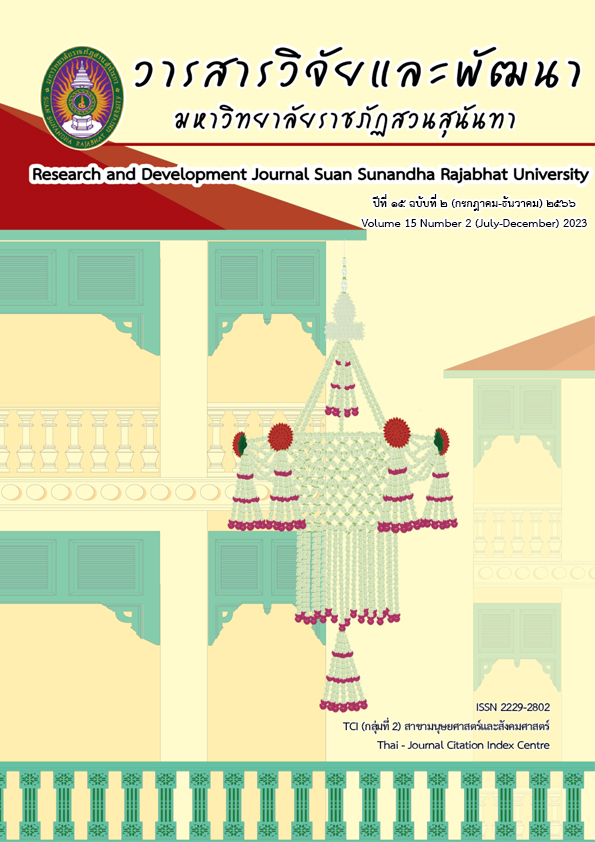การตกเป็นเหยื่อไซเบอร์ของกลุ่มวัยรุ่นในจังหวัดชลบุรี: การวิเคราะห์โมเดลมิมิค
คำสำคัญ:
การตกเป็นเหยื่อไซเบอร์, วัยรุ่น, เหยื่อ, การกลั่นแกล้ง, การวิเคราะห์โมเดลมิมิคบทคัดย่อ
การศึกษานี้มีวัตถุประสงค์เพื่อศึกษาระดับการตกเป็นเหยื่อไซเบอร์ของวัยรุ่นในจังหวัดชลบุรี และศึกษาโมเดลความสัมพันธ์ของเพศที่มีต่อการตกเป็นเหยื่อไซเบอร์ของวัยรุ่นในจังหวัดชลบุรี กลุ่มตัวอย่างที่ใช้ในงานวิจัยนี้ คือ นักเรียนและนักศึกษา อายุ 13-20 ปี ในจังหวัดชลบุรี จำนวน 534 คน ได้มาจากวิธีการสุ่มแบบหลายขั้นตอน เครื่องมือที่ใช้ในการเก็บรวบรวมข้อมูล คือ แบบสอบถามข้อมูลส่วนบุคคล และแบบทดสอบ Cybervictimization Questionnaire (CYVIC) for Adolescents แบบออนไลน์ มีค่าอำนาจจำแนกกรายข้อระหว่าง .20 - .85 ค่าความเชื่อมั่นทั้งฉบับ .90 วิเคราะห์ข้อมูลด้วยสถิติเชิงพรรณา ได้แก่ ความถี่ ร้อยละ ค่าเฉลี่ย และสถิติสำหรับวิเคราะห์โมเดลสมการโครงสร้างแบบ MIMIC Model ผลการวิจัยพบว่า ส่วนใหญ่นักเรียนในจังหวัดชลบุรีมีการตกเป็นเหยื่อไซเบอร์นาน ๆ ครั้ง และโมเดลสมการโครงสร้างความสัมพันธ์ของการตกเป็นเหยื่อไซเบอร์ของกลุ่มวัยรุ่นในจังหวัดชลบุรีมีความสอดคล้องกับข้อมูลเชิงประจักษ์ (มีค่าดัชนีความเหมาะสมสอดคล้อง: ค่า = 2.01, df = 3, P-Value = .57, GFI = .99, CFI = 1.00, TLI = 1.00, RMR = .00, RMSEA = .00) ดังนั้นจึงเป็นโมเดลที่เหมาะสมที่สุดสําหรับอธิบายความสัมพันธ์ของเพศที่มีต่อการตกเป็นเหยื่อไซเบอร์ของในจังหวัดชลบุรี ข้อเสนอแนะเชิงนโยบายจากผลการวิจัยนี้ คือ รณรงค์การใช้สื่อออนไลน์ที่ถูกต้องและเหมาะสม รวมทั้งสนับสนุนกิจกรรมในโลกไซเบอร์ที่สร้างสรรค์ และมีประโยชน์ให้กับนักเรียนหรือนักศึกษาในสถานศึกษาได้เข้าร่วม และควรกำหนดนโยบาย หรือกฎหมายเกี่ยวข้องกับการตกเป็นเหยื่อในโลกไซเบอร์ที่มีความชัดเจน และเหมาะสม
เอกสารอ้างอิง
Akbar, J., Huang, T. W., & Anwar, F. (2014). The development of cyberbullying scale to investigate bullies among adolescents. International Conference on Human-ities Sciences and Education (ICHE). Kuala Lumpur.
Alvarez-García, D., Núnez, J. C., Barreiro-Collazo, A., & García, T. (2017). Validation of the Cybervictimization Questionnaire (CYVIC) for adolescents. Computers in Human Behavior, 70(4), 270-281.
Athanasiou, K., Melegkovits, E., Andrie, E. K., Magoulas, C., Tzavara, C. K., Richardson, C., Greydanus, D., Tsolia, M. & Tsitsika, A. K. (2018). Cross-national aspects of cyberbullying victimization among 14–17-year-old adolescents across seven European countries. BMC Public Health, 18, 10-15.
Ayre, C., & Scally, J. (2014). Critical Values for Lawshe’s Content Validity Raio: Revisiting the Original Methods of Calculation. Measurement and Evaluation in Counseling and Development, 47, 79-86.
Cochran, W. G. (1953). Sampling Techniques. New York: John Wiley & Sons.
Cronbach, L. J. (1951). Coefficient alpha and the internal structure of tests. Psychometrika, 16(3), 297-334.
Curran, P. J., West, S., & Finch, J. F. (1996). The Robustness of Test Statistics to Nonnormality and Specification Error in Confirmatory Factor Analysis. Psychological Methods, 1(1), 16-29.
Electronic Transactions Development Agency. (2023). Thailand Internet User Behavior 2022. Bangkok: : Electronic Transactions Development Agency (In Thai).
Hooper, D., Coughlan, J., & Mullen, M. R. (2008). Structural Equation Modelling: Guidelines for Determining Model Fit. The Electronic Journal of Business Research Methods, 6, 53-60.
Kaspersky. (2016). Kaspersky Cybersecurity Index. Retrieved May 31, 2023, from https://www.techtalthai.com/kaspersky-cybersecurity-index
Khaosod. (2018). A dangerous virtual world in cyber online networks. Bangkok: Khaosod Co Ltd (In Thai).
Makmee, P. (2016). Development of A Model of Public Organizational Effectiveness Measurement in ASEAN: Multilevel Structural Equation Model Analysis. Journal of the Association of Researchers, 21(1), 34-48 (In Thai).
Pokpong, S., & Musikaphan, W. (2010). Behavior of cyberbullying among Thai youths in Bangkok. Bangkok: The Wisdom Society for Public Opinion Research of Thailand (In Thai).
Ronis, S., & Slaunwhite, A. (2017). Gender and Geographic Predictors of Cyberbullying Victimization, Perpetration, and Coping Modalities Among Youth. Canadian Journal of School Psychology, 34(1), 1-19.
Sittichai, R. (2014). Information technology behavior cyberbullying in Thailand: Incidence and predictors of victimization and cyber-victimization. Asian Social Science, 10(11), 132-139.
Suksawang, P. (2020). Structural Equation Modeling (3rd ed.). Chonburi: AP Blueprint (In Thai).
Tudkuea, T., & Laeheem, K. (2014). Development of indicators of cyberbullying among youths in Songkhla Province. Asian Social Science, 14(1), 74-79.
Yirci, R., Karakose, T., & Malkoç, N. (2021). Examining the Influence of Cyberbullying Perpetration and Victimization among High School Adolescents-Associations with Gender and Grade Level. Educational Process International Journal, 10(4), 55-72.
Young-Jin , L. (2015). Relations between virtues and positive mental health in a Korean population: A Multiple Indicators Multiple Causes (MIMIC) model approach. International Journal of Psychology, 50(4), 272-278.
ดาวน์โหลด
เผยแพร่แล้ว
รูปแบบการอ้างอิง
ฉบับ
ประเภทบทความ
สัญญาอนุญาต
ลิขสิทธิ์ (c) 2023 มหาวิทยาลัยราชภัฏสวนสุนันทา

อนุญาตภายใต้เงื่อนไข Creative Commons Attribution-NonCommercial-NoDerivatives 4.0 International License.
บทความที่ได้รับการตีพิมพ์เป็นลิขสิทธิ์ของ สถาบันวิจัยและพัฒนา มหาวิทยาลัยราชภัฎสวนสุนันทา
ข้อความที่ปรากฏในบทความแต่ละเรื่องในวารสารวิชาการเล่มนี้เป็นความคิดเห็นส่วนตัวของผู้เขียนแต่ละท่านไม่เกี่ยวข้องกับมหาวิทยาลัยราชภัฎสวนสุนันทา และคณาจารย์ท่านอื่นๆในมหาวิทยาลัยฯ แต่อย่างใด ความรับผิดชอบองค์ประกอบทั้งหมดของบทความแต่ละเรื่องเป็นของผู้เขียนแต่ละท่าน หากมีความผิดพลาดใดๆ ผู้เขียนแต่ละท่านจะรับผิดชอบบทความของตนเองแต่ผู้เดียว





